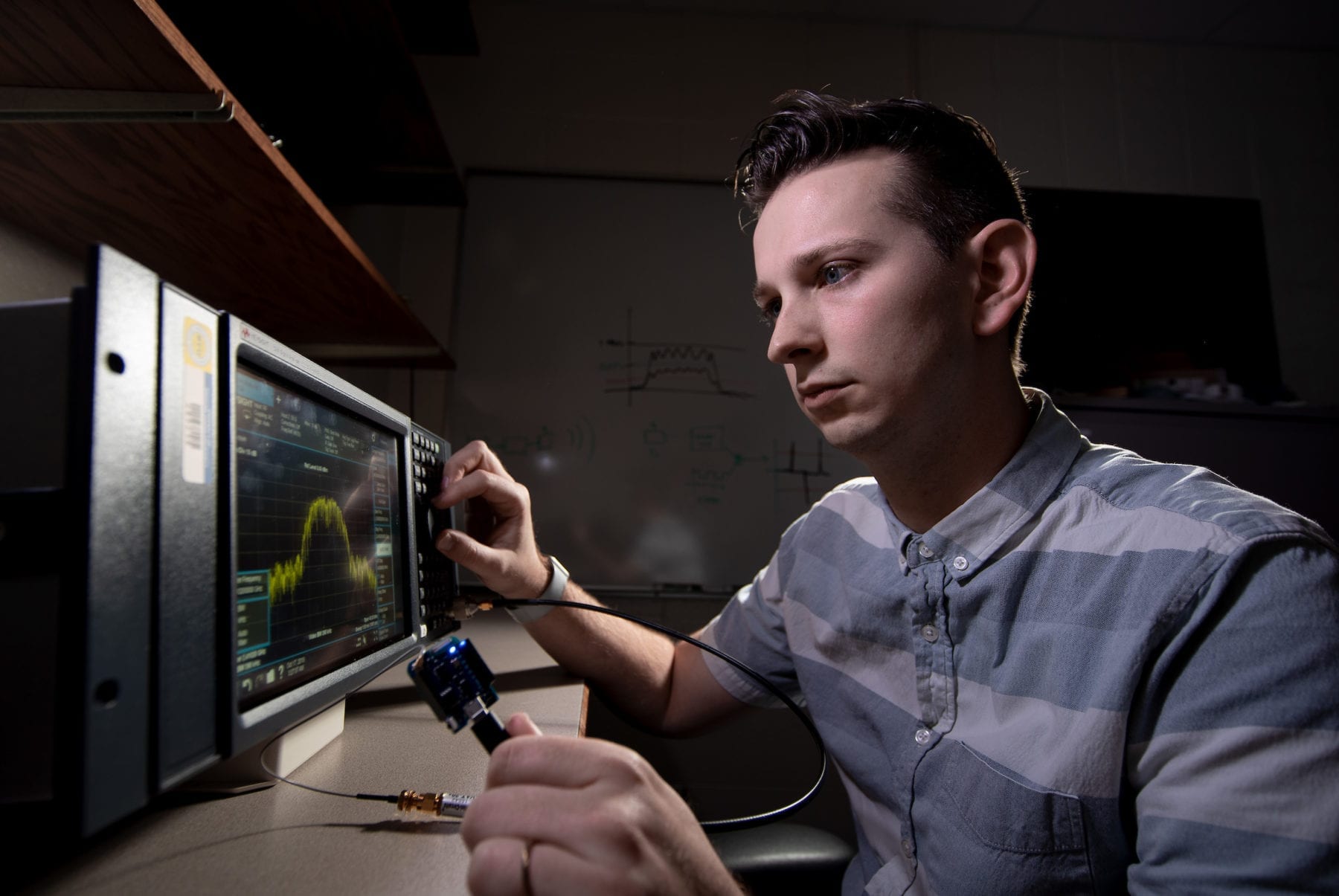
We might be one step closer to an Internet-of-things reality.
University of Washington engineers have created a new wireless communication system that allows devices to interact with each other without relying on batteries or wires for power.
The new communication technique, which the researchers call “ambient backscatter,” takes advantage of the TV and cellular transmissions that already surround us around the clock. Two devices communicate with each other by reflecting the existing signals to exchange information. The researchers built small, battery-free devices with antennas that can detect, harness and reflect a TV signal, which then is picked up by other similar devices.
The technology could enable a network of devices and sensors to communicate with no power source or human attention needed.
“We can repurpose wireless signals that are already around us into both a source of power and a communication medium,” said lead researcher Shyam Gollakota, a UW assistant professor of computer science and engineering. “It’s hopefully going to have applications in a number of areas including wearable computing, smart homes and self-sustaining sensor networks.”
The researchers published their results at the Association for Computing Machinery’s Special Interest Group on Data Communication 2013 conference in Hong Kong, which began Aug. 13. They have received the conference’s best-paper award for their research.
“Our devices form a network out of thin air,” said co-author Joshua Smith, a UW associate professor of computer science and engineering and of electrical engineering. “You can reflect these signals slightly to create a Morse code of communication between battery-free devices.”
Smart sensors could be built and placed permanently inside nearly any structure, then set to communicate with each other. For example, sensors placed in a bridge could monitor the health of the concrete and steel, then send an alert if one of the sensors picks up a hairline crack. The technology can also be used for communication – text messages and emails, for example – in wearable devices, without requiring battery consumption.
The researchers tested the ambient backscatter technique with credit card-sized prototype devices placed within several feet of each other. For each device the researchers built antennas into ordinary circuit boards that flash an LED light when receiving a communication signal from another device.
Groups of the devices were tested in a variety of settings in the Seattle area, including inside an apartment building, on a street corner and on the top level of a parking garage. These locations ranged from less than half a mile away from a TV tower to about 6.5 miles away.
The Latest Bing News on:
Internet of things
- Crypto? AI? Internet co-creator Robert Kahn already did it… decades agoon May 6, 2024 at 4:59 pm
You told it what you wanted to do and launched it — you know, make airplane reservations, check your email, look at the news, let you know about things that might affect you, just freed you up; it ...
- 3 Internet of Things (IoT) Stocks with the Potential to Make You an Overnight Millionaireon May 4, 2024 at 3:18 am
InvestorPlace - Stock Market News, Stock Advice & Trading Tips By now, you’ve heard of the Internet of Things (IoT) — or the ...
- Impinj Proves The Internet-of-Things (IoT) is No Flukeon May 1, 2024 at 4:30 am
Internet-of-Things (IoT) technology provider Impinj Inc. (NASDAQ: PI) is riding a strong secular tailwind as the world continues to become more connected. The computer and technology sector leader ...
- Internet of Thingson April 28, 2024 at 5:00 pm
Microchip has announced its most secure 32bit microcontrollers – a series of 120MHz Cortex-M33 MCUs for connected things. “Emerging requirements make security mandatory for the majority of IoT ...
- Shares of Internet of Things Play Impinj Soar on Strong Earnings and Outlookon April 26, 2024 at 12:17 am
Impinj stock skyrocketed Thursday after the chip provider offered robust guidance and better-than-expected earnings. The company manufactures radio-frequency identification, or RFID, chips for ...
- Internet of Things (IoT) Market to Expand at a Stellar 19.4% CAGR through 2031 | SkyQuest Technologyon April 25, 2024 at 3:45 am
Market will attain a value of USD 1572.37 billion by 2031, with a CAGR of 19.4% over the forecast period (2024-2031). Internet of Things (IoT) refers to the network of connected devices over the ...
- GigNet and IotaComm to Collaborate on Internet-of-Things (IoT) Solutions for the Mexican Caribbeanon April 22, 2024 at 2:20 pm
GigNet, a Digital Infrastructure company with an extensive regional fiber optic broadband network from Costa Mujeres, North of Cancun, through the Hot ...
- What You Should Know About The Internet Of Everythingon April 8, 2024 at 11:41 am
Do it now! As Scott J. Shackelford of the University of Indiana argues in his book The Internet of Things: What everyone needs to know: “We are just at the beginning of governing AI with ...
- internet of thingson April 2, 2024 at 4:59 pm
In today’s “predictable things that happened before and definitely will happen again”, we have another company in the “smart device” business that has just shuttered their servers ...
- Internet of Things (IoT)on March 15, 2024 at 2:04 am
UDRI works with industry and government clients to clarify needs and to design, develop, and integrate Internet of Things (IoT) solutions. Our researchers have developed and implemented IoT systems ...
The Latest Google Headlines on:
Internet of things
[google_news title=”” keyword=”Internet of things” num_posts=”10″ blurb_length=”0″ show_thumb=”left”]
The Latest Bing News on:
IoT
- The IOT Solutions World Congress Awards Selects 18 Finalist Projectson May 8, 2024 at 8:21 am
The jury of experts has judged the most outstanding initiatives in the modernization of manufacturing production, energy, smart buildings, healthcare, mobility and cybersecurity.
- IoT and the Smell of Fire: A Conversation with Dryad Networks for Wildfire Awareness Monthon May 8, 2024 at 8:20 am
We had the opportunity to speak at length with Carsten Brinkschulte, Dryad Networks co-founder and CEO. We discussed IoT sensor technology - powered by advanced ML models - that can 'smell' fires, in ...
- Global IoT Sensors Market to Surpass USD 107.74 Billion by 2031 | Skyquest Technologyon May 8, 2024 at 6:30 am
SkyQuest projects that the Global IoT Sensors Market will attain a value of USD 107.74 billion by 2031, with a CAGR of 28.60% over the forecast period (2024-2031). The automotive industry around the ...
- Matter IoT standard now supports EV chargers, kitchen and laundry appliances, and moreon May 8, 2024 at 5:31 am
Matter, the IoT standard, has added support for several new device categories including EV chargers, kitchen and laundry appliances, and more ...
- The Role of Edge Computing in IoT Performanceon May 7, 2024 at 10:38 am
Edge computing has emerged as a crucial solution to address the limitations of cloud computing in supporting context-aware and delay-sensitive services in the Internet of Things (IoT) era. This ...
- Smart Supply Chain Management: Implementing IoT Technologies To Optimize Supply Chain Visibilityon May 7, 2024 at 3:45 am
Supply chain management can benefit from technological advancements like the Internet of Things to improve connection and communication between different devices.
- Making Magic Across All Layers of the IoT Stackon May 6, 2024 at 9:44 am
Proof of this can be found in ECE 655: Full-Stack IoT Systems. Cross-listed in computer science and taught by Tingjun Chen, assistant professor of electrical and computer engineering, the relatively ...
- How to Approach the Risks of IoT Technologyon May 6, 2024 at 6:11 am
NIST offers manufacturers an array of cybersecurity information related to Internet of Things technologies—from device selection and implementation guidance to outlines on ...
- 3 Internet of Things (IoT) Stocks with the Potential to Make You an Overnight Millionaireon May 4, 2024 at 3:18 am
InvestorPlace - Stock Market News, Stock Advice & Trading Tips By now, you’ve heard of the Internet of Things (IoT) — or the ...
- 4 IoT Trends U.K. Businesses Should Watch in 2024on May 3, 2024 at 10:32 am
With help from Steve Statler, the chief marketing officer at IoT technology provider Wiliot, TechRepublic has identified the top four trends emerging in IoT that U.K. businesses should be aware of: ...
The Latest Google Headlines on:
IoT
[google_news title=”” keyword=”IoT” num_posts=”10″ blurb_length=”0″ show_thumb=”left”]










